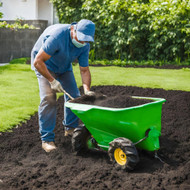A Comprehensive Fertiliser Buying Guide
Fertilisers play a pivotal role in ensuring the health and vitality of your plants, but navigating the world of Fertilisers can be overwhelming. With a plethora of options available, choosing the right Fertiliser for your garden becomes crucial. This comprehensive Fertiliser buying guide aims to simplify the process, providing valuable insights to help you make informed decisions and promote a flourishing garden.
Understand Your Soil
- Before diving into the world of Fertilisers, assess your soil's composition. Understanding the pH levels and nutrient content of your soil is crucial for selecting the right Fertiliser. Soil testing kits are readily available and can provide valuable insights.
Types of Fertilisers
- Organic vs. Synthetic: Understand the difference between organic and synthetic Fertilisers. Organic options include compost, manure, and bone meal, while synthetic Fertilisers are chemically formulated. Each has its advantages, so choose based on your gardening philosophy and needs.
NPK Ratio
- The three main nutrients essential for plant growth are nitrogen (N), phosphorus (P), and potassium (K). Fertiliser packaging displays these values in the NPK ratio (e.g., 10-20-10). Different plants have varied nutrient requirements at different growth stages, so choose a Fertiliser with the appropriate NPK ratio.
Slow-Release vs. Quick-Release
- Consider the release speed of nutrients. Slow-release Fertilisers provide a steady supply over time, promoting sustained growth, while quick-release options provide an immediate boost. Combining both types can offer a balanced approach.
Micronutrients
- In addition to the primary nutrients (N, P, K), plants require trace elements known as micronutrients. Look for Fertilisers that include essential micronutrients such as iron, zinc, and manganese to ensure comprehensive plant nutrition.
Application Methods
- Fertilisers come in various forms, including granules, liquids, and spikes. Consider the application method that suits your gardening style. Granular Fertilisers are ideal for even coverage, while liquid options are quick to absorb.
Seasonal Considerations
- Plants have varying nutrient needs throughout the growing season. Choose Fertilisers with formulations tailored to specific growth stages, such as pre-planting, flowering, or fruiting.
Environmental Impact
- Be mindful of the environmental impact of your Fertiliser choices. Some Fertilisers may contribute to water pollution or harm beneficial soil organisms. Opt for environmentally friendly options whenever possible.
Brand Reputation
- Choose reputable brands with a history of producing quality Fertilisers. Read reviews, seek recommendations, and ensure the product adheres to local regulations.
Storage and Handling
- Properly store and handle Fertilisers according to the manufacturer's instructions. Pay attention to expiration dates and avoid over-application, as excessive Fertiliser can harm plants.
A successful garden begins with choosing the right Fertiliser. By understanding your soil, considering nutrient ratios, and being mindful of environmental impact, you can make informed decisions. Remember, a well-nourished garden is a thriving garden. Happy gardening!

